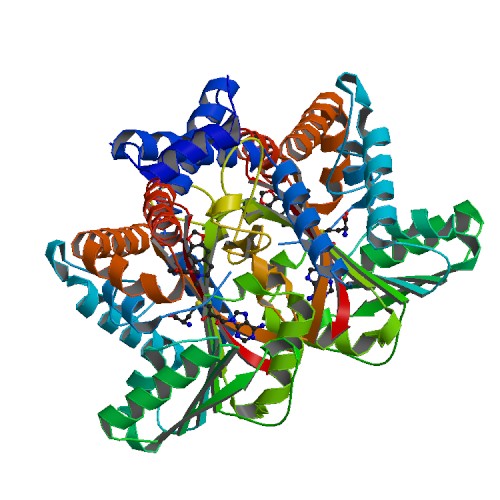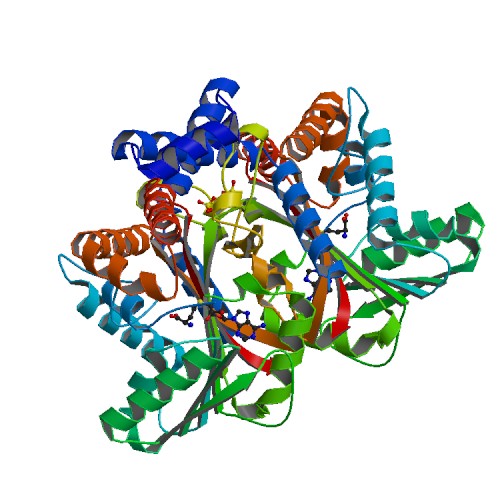Sandbox Reserved 1567
From Proteopedia
(Difference between revisions)
| Line 1: | Line 1: | ||
| - | + | = Structure = | |
| - | = | + | <StructureSection load='6P3N' size='340' side='right' caption='Tetrahydroprotoberbine' scene=''> |
| - | <StructureSection load=' | + | '''Tetrahydroprotoberbine N-methyltransferase''' is a protein thats dimer interface includes six salt 6 salt bridges and 8 hydrogens bonds. It is expressed in E. ''coli'' and crystallized at a pH of 7.0. The crystals were grown in the presence of SAH,SAM, and SAH+SMS. Below are the two different substrates that were in the presence of the crystallized protein. The substrate SAM is shown to the right. |
| - | + | [[Image:6p3o.pdb1-500.jpg]] | |
| - | + | [[Image:6p3m.pdb1-500.jpg]] | |
| + | = Function = | ||
| + | The protein being studied, Tetrahydroprotoberbine N-methyltransferase, is found in yellow horned poppy (''Glaucium Flavum''). The function of the protein is substate recognition as well as catalysis for the ration engineering of enyzmes for chemoenzymatic synthesis and metabolic engineering. The relative activity of about 8 substrates were tested wiht Protoberberine having the highest percentage. GfTNMT's activity depends on temperature and pH. When the enzyme's activity was at a pH of 8, dropped 10% in activity. 10% activity was also dropped when the temperature was at 30 degrees Celsius. When at 4 degrees Celsius, the activity dropped even more down to 40%. | ||
| + | = Mutants = | ||
| + | In TMNT, three amino acid residues in the alpha14-helix form one side of the <scene name='82/829888/Binding_pocket/1'>binding pocket</scene> defining the BP region. The binding pocket consists of His-328(green), Ile-329(purple), and Phe-332(orange). The H328 mutation decreases in activity with stylopine and scoulerine producing a 5- and 2-fold while the activity with THP increases 2-fold. | ||
| + | = Relevance = | ||
| + | Studying Tetrahydroprotoberbine will provide commercial application where one will gain a lot of knowledge from both the research paper and online sources. Studying this protein will allow readers to engage in the material and apply their own knowledge to better understand the study. This research will provide descriptive roles that TNMT plays such as pathway leading to the formation of different substrates including Protoberberine. <ref> Takao, N., Kamigauchi, M., and Okada, M. (1983) Biosynthesis of benzo-[c]phenanthridine alkaloids sanguinarine, chelirubine and macarpine.Helv. Chim. Acta 66, 473–484 CrossRef </ref> | ||
| + | = Structural Highlights = | ||
| + | This protein has a <scene name='82/829888/Catalytic_triad/7'>catalytic triad</scene> which consists of amino acids His-208, Glu-204, and Glu-207. The authors explained within the paper that other amino acids may play a role in the triad as well. They were unsure but those three were the most accurate. These amino acids play an important role in catalysis for the protein. <ref> Bennett, M. R., Thompson, M. L., Shepherd, S. A., Dunstan, M. S., Herbert, A. J., Smith, D. R. M., Cronin, V. A., Menon, B. R. K., Levy, C., and Micklefield, J. (2018) Structure and biocatalytic scope of coclaurine Nmethyltransferase.Angew. Chem. Int. Ed. Engl. 57, 10600–10604CrossRef | ||
| + | Medline </ref>. The basic <scene name='82/829888/Spacefill_view_of_protein/1'>spacefill view</scene> of the entire protein alllows readers to visualize the different elements show in different colors. The elements shown are carbons(grey), nitrogen(blue), and oxygen(red). This protein has a <scene name='82/829888/Ligand/1'>ligand</scene> which is SAM. There are <scene name='82/829888/Hydrophilic_side_chains/1'>hydrophilic side chains</scene>of SAM that form a small catalytic pocket and surrounds the amino group and methyl donor of SAM. This catalytic pocket forms a L shape. In green Glu-204, yellow is Glu-207, red is His-208, and Tyr-81 is blue. The <scene name='82/829888/Active_site/3'>active site</scene> of the protein consists of amino acids Valine-188(yellow), Aspartic Acid-187(blue), and Alanine-186(green), with purple being the rest of the ligand, SAM. The active site is the region where substrate molecules bind and undergo a chemical reaction. The <scene name='82/829888/Secondary_structure/1'>secondary structure</scene> of this protein contains a pattern of hydrogen bonds between atoms in the peptide bond. This cartoon view allows readers to visualize the alpha(pink) and beta sheets(yellow). The protein consists of two regions which are <scene name='82/829888/Polar_and_non-polar/1'>polar and non-polar regions</scene>. The non-polar region is in grey while the polar region is in purple. The <scene name='82/829888/Cationic_region/1'>cationic region</scene> of the protein has a side chain of Lysine, Arginine, Aspartic Acid, and Glutamic Acid. The cationic region is in the light blue. | ||
| - | == | + | = Energy Transformation = |
| + | There isn't any energy transformation data presented in the paper. | ||
| + | </StructureSection> | ||
| - | == Broader Implications == | ||
| - | |||
| - | == Structural highlights and structure-function relationships == | ||
| - | |||
| - | == Energy Transformation == | ||
| - | |||
| - | This is a sample scene created with SAT to <scene name="/12/3456/Sample/1">color</scene> by Group, and another to make <scene name="/12/3456/Sample/2">a transparent representation</scene> of the protein. You can make your own scenes on SAT starting from scratch or loading and editing one of these sample scenes. | ||
| - | |||
| - | </StructureSection> | ||
== References == | == References == | ||
<references/> | <references/> | ||
Revision as of 14:16, 2 December 2019
Structure
| |||||||||||
References
- ↑ Takao, N., Kamigauchi, M., and Okada, M. (1983) Biosynthesis of benzo-[c]phenanthridine alkaloids sanguinarine, chelirubine and macarpine.Helv. Chim. Acta 66, 473–484 CrossRef
- ↑ Bennett, M. R., Thompson, M. L., Shepherd, S. A., Dunstan, M. S., Herbert, A. J., Smith, D. R. M., Cronin, V. A., Menon, B. R. K., Levy, C., and Micklefield, J. (2018) Structure and biocatalytic scope of coclaurine Nmethyltransferase.Angew. Chem. Int. Ed. Engl. 57, 10600–10604CrossRef Medline


